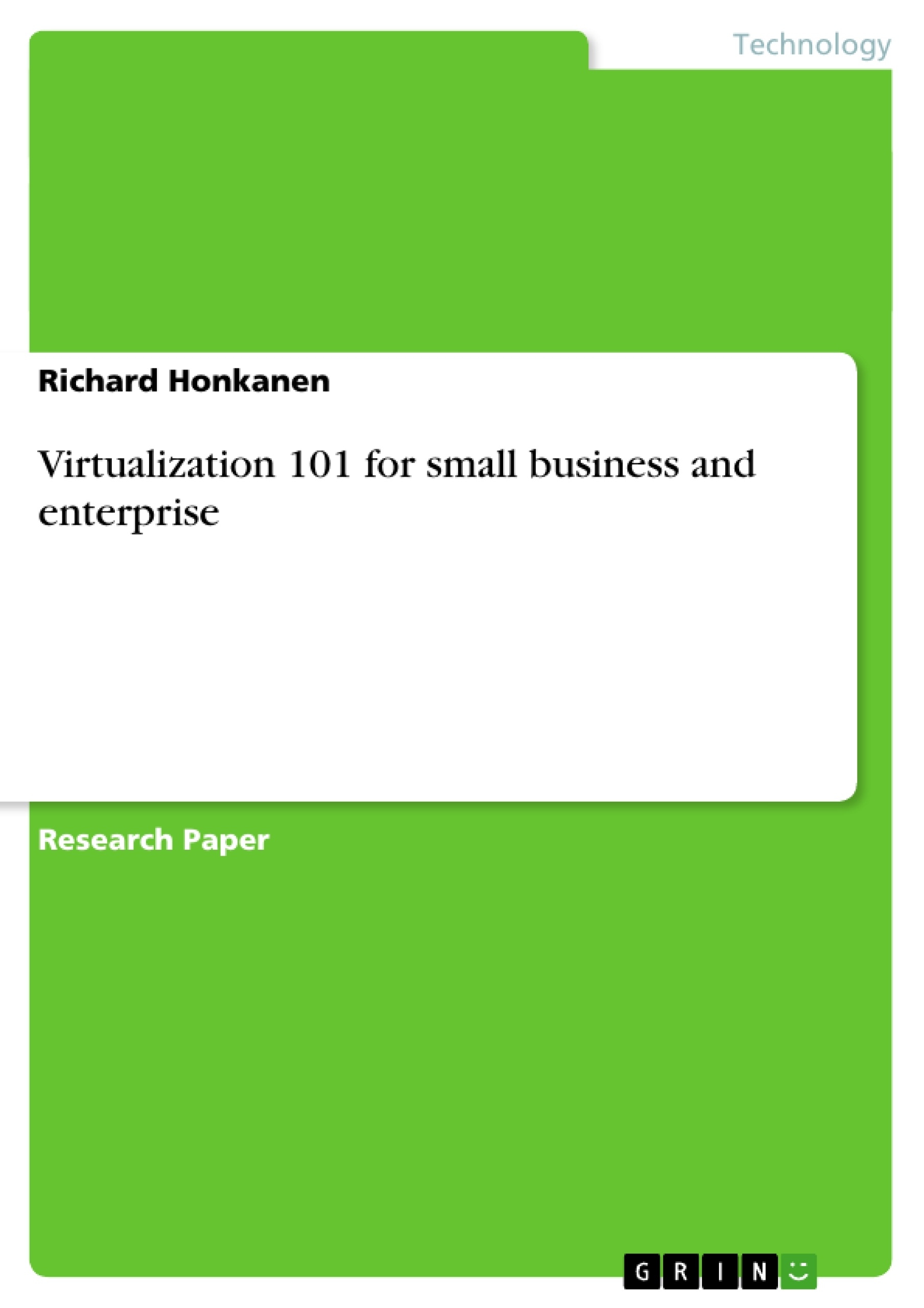Virtualization is a new and emerging technology that is rapidly growing, taking industry by
storm. In business, virtualization has become a new buzz word, but not many decision-makers
actually understand what it is. In today’s fiercely competitive world, it is crucial for decisionmakers
to learn more about virtualization to see if it can give their organizations leverage over
their competition. Not only that, virtualization can save businesses of all sizes a lot of money. Summed up in one sentence, virtualization is an information technology (IT) logistics strategy
that can save businesses time and money. Today, most IT data centers use one machine for one
server (e.g. one machine to serve e-mail, one for data, one for the website, etc.), causing server
sprawl. Eventually businesses run out of room for new machines, leaving them stuck in a bad
position. With virtualization, each server’s programs, files, and processes are merged into one
file (an image), and is then placed among other images on one machine. Consolidation of IT
resources improves server utilization and consequently increases efficiency, lowers the
electricity bill, and reduces physical footprint. It also makes deploying new servers cheap. A
different approach to virtualization is making multiple physical resources appear as one physical
resource, simplifying data-center operations and network administration through one
consolidated virtual environment.
The advantages of virtualization are almost infinite, but the main points are business continuity,
saving money through outsourcing data-processing (cloud computing), and preserving legacy
applications. The disadvantages are possible security problems, an initial investment up-front,
and uncertainty about the roll-out process (e.g. bugs that take time to work out).
Inhaltsverzeichnis (Table of Contents)
- Executive Summary
- Introduction
- Background and Purpose
- Scope and Limitations
- Methodology
- Thesis
- Report Organization
- Virtualization 101
- What is Virtualization?
- Who is Virtualization for? Why?
- The Four Pillars of Virtualization
- Compatibility
- Isolation
- Encapsulation
- Hardware Independence
- Common Questions
- Is virtualization a fad?
- Is virtualization more efficient, productive, and cost-effective in the long run?
- Does virtualization replace the need for small business to have tech-support on payroll?
- Are the cost savings for enterprise negligible?
- Where is virtualization at today, and is it useful in its current form?
- Applications of Virtualization
- Business Continuity and Disaster Recovery
- Cloud Computing
- Load-Balancing
- Security Concerns
- Pros and Cons of Virtualization
- Conclusion
- Works Cited
Zielsetzung und Themenschwerpunkte (Objectives and Key Themes)
This report aims to provide a comprehensive overview of virtualization technology, specifically focusing on its relevance and potential benefits for small businesses and enterprises. It explores the key concepts, advantages, and disadvantages of virtualization, while also addressing common questions and concerns. The report aims to equip decision-makers with the necessary information to make informed decisions about implementing virtualization within their organizations.
- Understanding the concept of virtualization and its core principles.
- Evaluating the potential benefits of virtualization for small businesses and enterprises.
- Exploring the various applications of virtualization, including business continuity, cloud computing, and load balancing.
- Analyzing the pros and cons of virtualization, including potential security risks and cost considerations.
- Providing insights into the current state of virtualization and its future prospects.
Zusammenfassung der Kapitel (Chapter Summaries)
The Executive Summary provides a concise overview of virtualization, highlighting its potential to save businesses time and money by consolidating IT resources and improving server utilization. It also outlines the key advantages and disadvantages of virtualization, emphasizing the need for careful consideration before implementation.
The Introduction section delves deeper into the background and purpose of the report, explaining the need for a comprehensive resource on virtualization that caters to both small businesses and enterprises. It also defines the scope and limitations of the report, clarifying the target audience and the level of technical detail covered.
The "Virtualization 101" chapter provides a detailed explanation of virtualization, defining its core concepts and outlining its four pillars: compatibility, isolation, encapsulation, and hardware independence. It also addresses common questions about virtualization, such as its efficiency, cost-effectiveness, and relevance in today's business environment.
The "Applications of Virtualization" chapter explores various practical applications of virtualization, including business continuity and disaster recovery, cloud computing, and load balancing. It also discusses potential security concerns associated with virtualization.
The "Pros and Cons of Virtualization" chapter presents a balanced analysis of the advantages and disadvantages of virtualization, highlighting its potential benefits while acknowledging potential challenges and risks.
Schlüsselwörter (Keywords)
The keywords and focus themes of the text include virtualization, server virtualization, small business, enterprise, business continuity, disaster recovery, cloud computing, load balancing, security, cost-effectiveness, efficiency, and IT logistics.
- Citar trabajo
- Richard Honkanen (Autor), 2008, Virtualization 101 for small business and enterprise, Múnich, GRIN Verlag, https://www.grin.com/document/112847
-

-

-

-
¡Carge sus propios textos! Gane dinero y un iPhone X. -

-
¡Carge sus propios textos! Gane dinero y un iPhone X. -

-
¡Carge sus propios textos! Gane dinero y un iPhone X. -

-
¡Carge sus propios textos! Gane dinero y un iPhone X. -

-
¡Carge sus propios textos! Gane dinero y un iPhone X.

